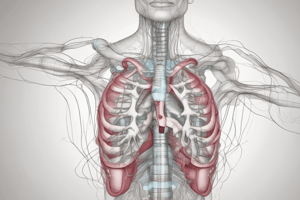Podcast
Questions and Answers
What is the primary function of the skeletal system?
What is the primary function of the skeletal system?
- To regulate hormone production
- To control the body's metabolism
- To filter waste and excess fluids from the blood
- To provide movement and protection (correct)
What is the function of the antidiuretic hormone secreted by the posterior pituitary gland?
What is the function of the antidiuretic hormone secreted by the posterior pituitary gland?
- To increase glucose levels in the bloodstream
- To stimulate the production of insulin
- To regulate the balance of water and salts in the kidneys (correct)
- To regulate thyroid hormone production
Which type of muscle is found in the heart?
Which type of muscle is found in the heart?
- Skeletal muscle
- Cardiac muscle (correct)
- Voluntary muscle
- Smooth muscle
What is the function of the pancreatic hormone glucagon?
What is the function of the pancreatic hormone glucagon?
What is the name of the valve whose closing produces the 'lub' sound?
What is the name of the valve whose closing produces the 'lub' sound?
What is the primary function of the respiratory system?
What is the primary function of the respiratory system?
Which blood vessels are responsible for the exchange of oxygen and carbon dioxide in the lungs?
Which blood vessels are responsible for the exchange of oxygen and carbon dioxide in the lungs?
What is the path that an oxygen molecule takes to reach a cell?
What is the path that an oxygen molecule takes to reach a cell?
What is the function of the tricuspid valve in the heart?
What is the function of the tricuspid valve in the heart?
What is the difference between the pulmonary circuit and the systemic circuit?
What is the difference between the pulmonary circuit and the systemic circuit?
Flashcards are hidden until you start studying
Study Notes
Circulatory System
- Deoxygenated blood flows from the inferior and superior vena cava to the right atrium, then to the right ventricle, to the pulmonary artery, and finally to the lungs.
- Oxygenated blood returns to the left atrium via the pulmonary veins, then to the left ventricle, and finally to the aorta, which distributes it to the rest of the body.
- The "lub dub" sounds are created by the atrial valves closing ("lub") and the mitral valves closing ("dub").
Endocrine System
- The endocrine system controls the endocrine glands that produce and release hormones into the circulatory system.
- Examples of glands that are part of other systems include the pancreas, which secretes hormones for sugar regulation and digestion.
- A hormone is a chemical substance produced by an endocrine gland that acts on another part of the body.
- Endocrine glands and their hormones include:
- Pituitary gland: growth hormone, prolactin, thyroid-stimulating hormone
- Thyroid: thyroxine, triiodothyronine, calcitonin
- Parathyroid: parathyroid hormone (regulates calcium balance)
- Adrenal: aldosterone, cortisol, epinephrine, norepinephrine
- Pancreas: insulin, glucagon
Skeletal and Muscular Systems
- The skeletal system provides protection and movement, while the muscular system facilitates movement.
- Muscles attach to bones to produce movement when they contract.
- The skeletal system has two divisions: axial and appendicular.
- There are 206 bones in the adult human body, on average.
- Joints are classified as sutures (found only in the skull), cartilaginous (connected by cartilage), and synovial (with a synovial cavity).
- There are three types of muscle:
- Skeletal muscle: voluntary, multinucleated
- Smooth muscle: involuntary, single nucleus
- Cardiac muscle: branched, multinucleated (heart muscle)
Respiratory and Circulatory Systems
- The respiratory system extracts oxygen from the air and removes CO2, while the circulatory system brings O2 to the body and removes CO2.
- Blood capillaries in the alveoli enable the exchange of O2 and CO2.
- The respiratory system consists of:
- Mouth and nose
- Pharynx (throat)
- Larynx (voice box)
- Trachea
- Primary bronchi
- Bronchi
- Bronchioles
- Respiratory bronchioles
- Alveolar ducts
- Alveolar sacs (with 20-30 alveoli per sac)
- The heart has four chambers: two atria and two ventricles.
- Valves involved in moving blood throughout the heart include the tricuspid, bicuspid, and mitral valves.
- The pulmonary circuit involves the flow of deoxygenated blood from the right ventricle to the lungs and back to the left atrium. The systemic circuit involves the flow of oxygenated blood from the left ventricle to the aorta and the rest of the body.
Studying That Suits You
Use AI to generate personalized quizzes and flashcards to suit your learning preferences.




